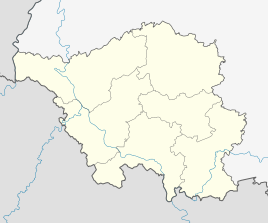Gresaubach
|
Gresaubach
City of Lebach
|
||
|---|---|---|
| Coordinates: 49 ° 27 '7 " N , 6 ° 53' 50" E | ||
| Height : | 264 m | |
| Residents : | 1805 (Dec. 31, 2019) | |
| Incorporation : | 1st January 1974 | |
| Postal code : | 66822 | |
| Area code : | 06887 | |
|
Location of Gresaubach in Saarland |
||
Gresaubach is a district of Lebach in the Saarlouis district in Saarland . Until 1973 Gresaubach was an independent municipality.
Geographical location
The village of Gresaubach is located almost in the geographic center of the Saarland . Although the region is strongly characterized by agriculture, a large part of the employees worked in the Saarland coal and steel industry and in mining until the end of the 1990s . The recent structural change is shifting the job description here, as in the neighboring communities, more and more to the service sector.
history
The landscape in which the place is embedded has been populated since the Paleolithic . Finds from Limbach, Schmelz and Hüttersdorf show that people lived here very early. Since the Iron Age , the Celtic culture (the Celtic tribe of the Treveri ) dominated more and more , which can be proven by the proximity to the Hunnenring in Otzenhausen . Later in history, the Romans built a trade route from Strasbourg to Trier , which ran along the Hüttersdorf-Niederlosheim line and brought the area into contact with Roman culture. After the collapse of the Roman Empire, the country came under Celtic / Germanic influences, to which Christianization was mainly due to St. Wendalinus joined. When around the eighth century new cultivated land was opened up in the course of forest clearing, the place developed from a small hamlet-like settlement.
The region around Gresaubach belonged to the Counts of Blieskastel in the 11th century. After various succession disputes, the Schaumburg office and with it the place fell to the Lorraine dynasty, in whose possession it remained for almost 500 years.
In 1786 the office of Schaumburg was transferred to the Duchy of Palatinate-Zweibrücken by means of an exchange contract , which, however, was repealed in 1789 for the French Revolution . Was assigned to the canton of Tholey until 1814 , in the Moselle department .
The Sacred Heart Church was built in 1910.
Place name
The origin of the place name can no longer be traced with absolute certainty. At the beginning of the 16th century it was still Subach , whereby the prefix “ Su- ” is probably derived from Sur , which was used for “sour”, “boggy”, “moist” in the linguistic usage at the time. In the course of time, the name underwent a phonetic and content-related change towards "pig". It is even more difficult to determine where the “Gre-” prefix came from. It is believed that the place had to distinguish itself from other settlements on the Subach and introduced "capital", "Greesser-" as a prefix, which developed into the current place name.
Incorporation
On January 1, 1974, Gresaubach was incorporated into the municipality of Lebach.
Former municipal coat of arms
- The wavy line that divides the coat of arms horizontally symbolizes the location of the place on the "Saubach", a body of water that rises in the place and flows into the Theel near Lebach .
- On the right (heraldic point of view) at the top, the Lorraine Cross documents that the region belonged to the Duchy of Lorraine until the end of the 18th century.
- At the top left, the shovel and pike symbolize the town's past as a supplier of raw ore, which was collected for days at the beginning of the 17th century and delivered to Bettingen and Dillingen . The inhabitants' identification with mining and the steel industry persisted well into the 20th century, when a large part of the population was employed in this economic sector.
- The agriculture significantly shaped the place, which in the coat of arms right is symbolized below by ears.
- Finally, the shepherd's staff is the symbol of St. Wendalinus , to whom the old chapel in Gresaubach was consecrated and to whom a street in the village is still dedicated today.
Web links
Individual evidence
- ↑ Population status_31.12.2019 on lebach.de
- ^ Federal Statistical Office (ed.): Historical municipality directory for the Federal Republic of Germany. Name, border and key number changes in municipalities, counties and administrative districts from May 27, 1970 to December 31, 1982 . W. Kohlhammer, Stuttgart / Mainz 1983, ISBN 3-17-003263-1 , p. 807 .


